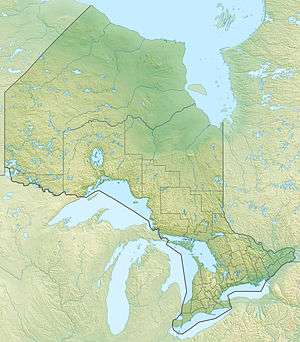Verulam Formation
The Verulam Formation is a geologic formation in Ontario. It preserves fossils dating back to the Katian stage of the Ordovician period, or Shermanian to Chatfieldian in the regional stratigraphy.[1]
| Verulam Formation Stratigraphic range: Katian (Shermanian-Chatfieldian) ~455–446 Ma | |
|---|---|
| Type | Formation |
| Unit of | Simcoe Group |
| Sub-units | Cystid Beds |
| Overlies | Bobcaygeon Formation |
| Lithology | |
| Primary | Limestone |
| Other | Mudstone, shale, siltstone |
| Location | |
| Coordinates | 44.6°N 79.1°W |
| Approximate paleocoordinates | 23.9°S 52.1°W |
| Region | Ontario |
| Country | |
| Type section | |
| Named by | Liberty |
| Year defined | 1969 |
 Verulam Formation (Canada)  Verulam Formation (Ontario) | |
Description
The Verulam Formation belongs to the Simcoe Group and overlies the Bobcaygeon Formation. Both the Bobcaygeon and Verulam Formations are composed of bioclastic wackestones, grainstones, and packstones interbedded with calcareous shales and siltstones. The Verulam contains more shale than the underlying Bobcaygeon Formation. Several hardgrounds have been documented in detail from the upper Bobcaygeon and lower Verulam. The paleoenvironments in which the Bobcaygeon and Verulam Formations were deposited have been interpreted as a proximal carbonate shelf that ranged in depth and proximity from shoal to shallow shelf in the Bobcaygeon and from deep shelf to shoal or shallow shelf in the Verulam Formation.[2]
Fossil content
The Verulam Formation and the underlying Bobcaygeon Formation have provided many fossils. Both formations form the Brechin Lagerstätte, a Lagerstätte of excellent preservation of numerous exceptionally preserved crinoid specimens with arms, stems, and attachment structures intact.[2][3][4] Also ostracods, trilobites, bivalves, gastropods, cephalopods and other fossils were found in the formation.[5]
- Crinoids
- Abludoglyptocrinus steinheimerae[6]
- Pararchaeocrinus kiddi[6]
- Periglyptocrinus astricus[6]
- Cheirocrinus logani[7]
- Cupulocrinus jewetti[3]
- Praecupulocrinus conjugans
- Iocrinus trentonensis
- Eustenocrinus springeri
- Cremacrinus guttenbergensis
- C. inaequalis
- Daedalocrinus bellevillensis
- Cincinnaticrinus varibrachialus
- Anomalocrinus astrictus
- Protaxocrinus laevis
- Cupulocrinus humilis
- C. jewetti
- Plicodendrocrinus proboscidiatus
- Simcoecrinus mahalaki
- Dendrocrinus simcoensis
- Grenprisia billingsi
- Illemocrinus amphiatus
- Porocrinus conicus
- Carabocrinus vancortlandti
- Hybocrinus tumidus
- Hybocystites problematicus
- Konieckicrinus brechinensis
- K. josephi
- Reteocrinus alveolatus
- R. stellaris
- Archaeocrinus maraensis
- A. sundayae
- Porocrinus conicus
- Palaeocrinus pulchellus
- Ottawacrinus sp.
- Trilobites
- Encrinurus cybeleformis
- Erratencrinurus vigilans
- Flexicalymene senaria
- Isotelus gigas
- Ceraurinus marginatus
- Ceraurus pleurexanthemus
- cf. Achatella achates
- Bathyurus (Raymondites) ingalli
- Bumastoides sp.
- Calyptaulax sp.
- Encrinuroides sp.
- Ceraurus sp.
- Flexicalymene sp.
- Isotelus sp.
- Hemiarges sp.
- Amphilichas sp.
- Bumastoides sp.
- Ceraurus sp.
- Isotelus sp.
- Edrioasteroidea
- Thresherodiscus ramosus[8]
- Ostracods
- Thomasatia sp.
- Bassleratia sp.
- Eoleperditia sp.
- Strophomenata
- Sowerbyella sp.
- Rafinesquina sp.
- Oepikina sp.
- Rhynchonellata
- Anazyga sp.
- Zygospira sp.
- Rhynchotrema sp.
- Resserella sp.
- Dinorthis sp.
- Hesperorthis sp.
- Platystrophia sp.
- Plectorthis sp.
- Bivalves
- Cyrtodonta subangulata
- Clionychia undata
- Plaesiomys subcircularis[9]
- Ambonychia cf. orbicularis
- Ctenodonta cf. simulatrix
- Ambonychia sp.
- Ctenodonta sp.
- Nuculites sp.
- Tancrediopsis sp.
- Gastropods
- Bucania halli
- Hormotoma gracilis
- Sinuites cancellatus
- Eotomaria dryope
- Alaskadiscus disculus
- Cyrtostropha salteri canadensis
- Fusispira elongata
- F. angusta
- Pterotheca sp.
- Liospira sp.
- Lophospira sp.
- Hormotoma sp.
- Subulites sp.
- Fusispira sp.
- Cephalopods
- Stenolaemata
- Mesotrypa angularis
- M. quebecensis
- M. whiteavesi
- Homotrypa minnesotensis
- Prasopora grandis
- P. insularis
- P. simulatrix
- Eridotrypa aedilis
- Pachydictya sp.
- Stictoporella sp.
- Hallopora sp.
- Mesotrypa sp.
- Prasopora sp.
- Rhinidictya sp.
- Batostoma sp.
- Hallopora multitabulata
- Scyphozoa
- Climacoconus sp.
- Rhombifera
- Glyptocystites sp.
- Isorophusella sp.
- Cryptogoleus sp.
- Chlorophyceae
- Ischadites sp.
See also
- List of fossiliferous stratigraphic units in Ontario
- Arnheim Formation, contemporaneous fossiliferous formation of Ohio
- San Benito Formation, contemporaneous fossiliferous formation of Bolivia
- Late Ordovician glaciation
- Ordovician meteor event
- Taconic orogeny
References
- Verulam Formation
- Carden Quarry at Fossilworks.org
- Wright et al., 2019
- Cole et al., 2018
- Waddington, 1980
- Cole et al., 2020
- Wilson, 1946
- Sumrall & Gahn, 2006
- Sproat & Jin, 2013
Bibliography
- Cole, Selina R.; David F. Wright; 2020. Paleocommunity composition, relative abundance, and new camerate crinoids from the Brechin Lagerstätte (Upper Ordovician). Journal of Paleontology Online edition. .. doi:10.1017/jpa.2020.32
- Wright, D.F.; S.R. Cole, and W.I. Ausich. 2019. Biodiversity, systematics, and new taxa of cladid crinoids from the Ordovician Brechin Lagerstätte. Journal of Paleontology x. 1.
- Cole, S.R.; W.I. Ausich; D.F. Wright, and J.M. Koniecki. 2018. An echinoderm Lagerstätte from the Upper Ordovician (Katian), Ontario: taxonomic re-evaluation and description of new dicyclic camerate crinoids. Journal of Paleontology x. 1-18.
- Sproat, C.D., and J. Jin. 2013. Evolution of the Late Ordovician plaesiomyid brachiopod lineage in Laurentia. Canadian Journal of Earth Sciences 50. 872-894.
- Sumrall, C.D., and F.J. Gahn. 2006. Morphological and systematic reinterpretation of two enigmatic edrioasteroids (Echinodermata) from Canada. Canadian Journal of Earth Sciences 43. 497-507.
- Peters, S.E. 2003. Evenness, richness and the Cambrian-Paleozoic faunal transition in North America: an assemblage-level perspective, 1-279. University of Chicago.
- Waddington, J.B. 1980. A soft substrate community with edrioasteroids, from the Verulam Formations (Middle Ordovician) at Gamebridge, Ontario. Canadian Journal of Earth Sciences 17. 674-679.
- Liberty, B.A. 1969. Palaeozoic geology of the Lake Simcoe Area, Ontario. Geological Survey of Canada Memoirs 355. 1-201.
- Wilson, A.E. 1951. Gastropoda and Conularida of the Ottawa Formation of the Ottawa - St. Lawrence Lowland. Geological Survey of Canada Bulletin 17. 1-149.
- Wilson, A.E. 1946. Echinodermata of the Ottawa Formation of the Ottawa-St. Lawrence lowland. Geological Survey of Canada Bulletin 4. 1-61.